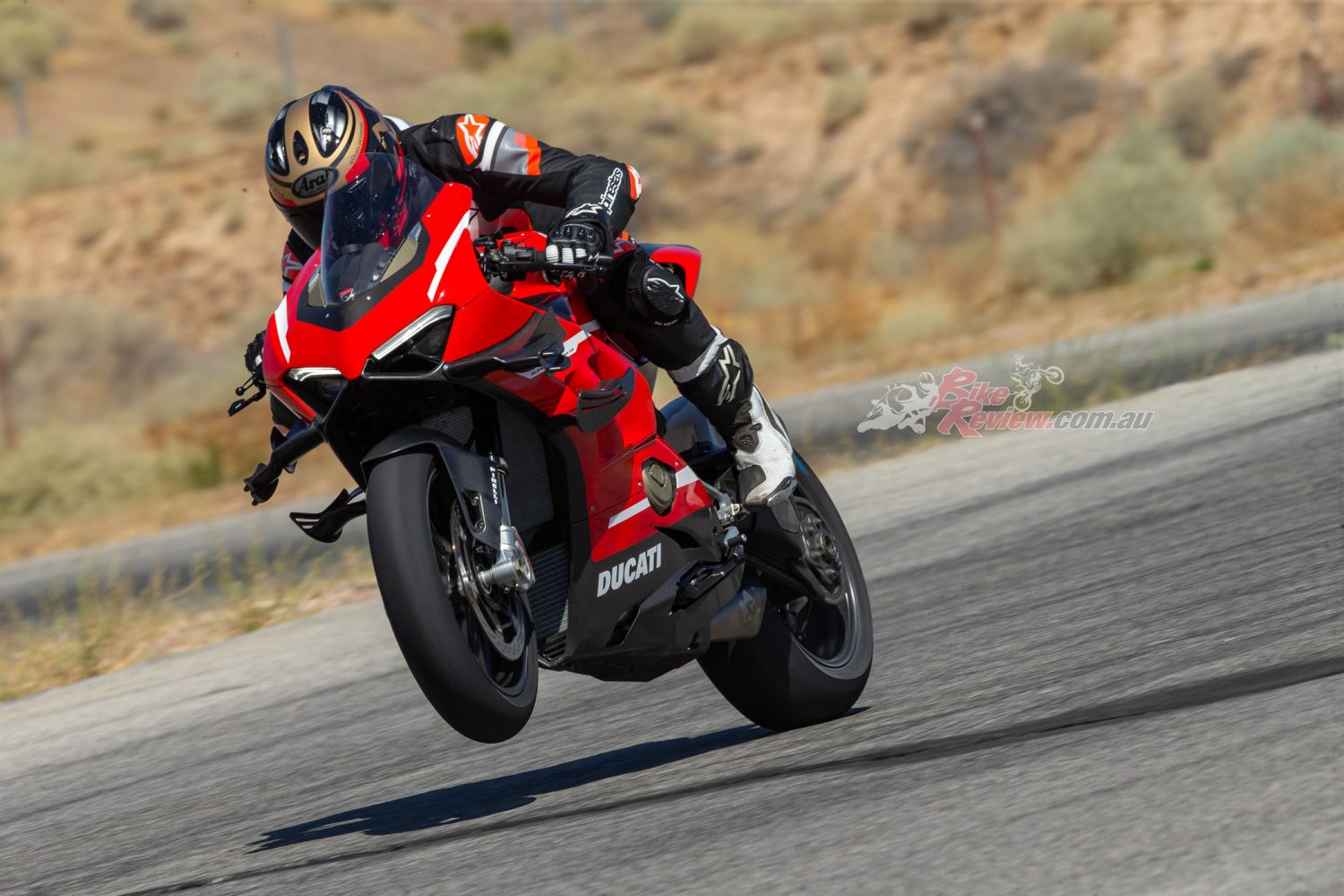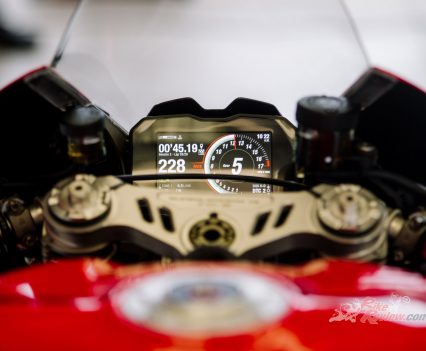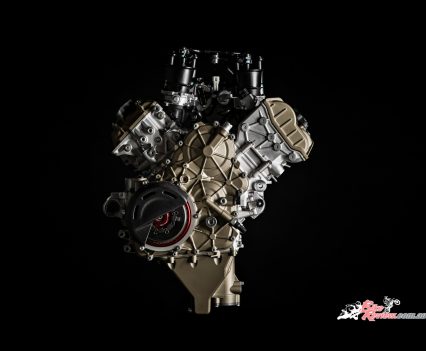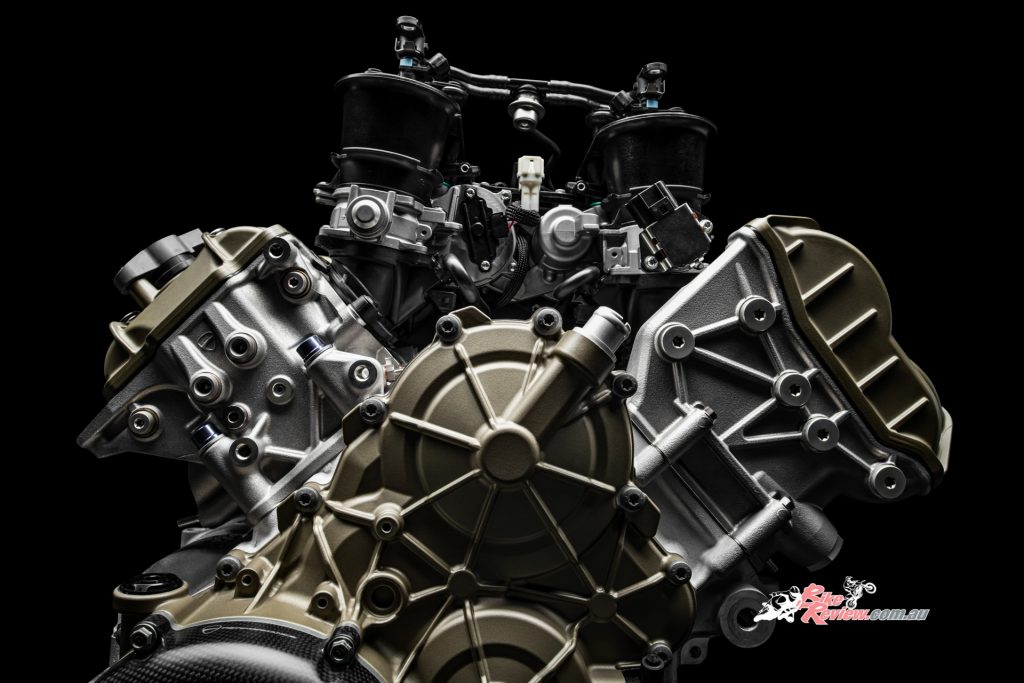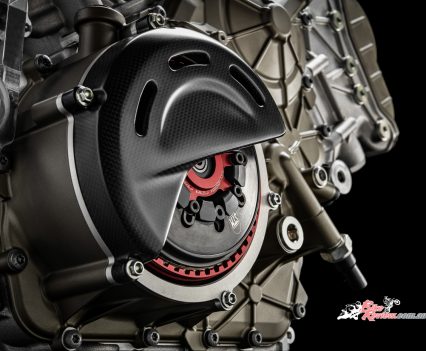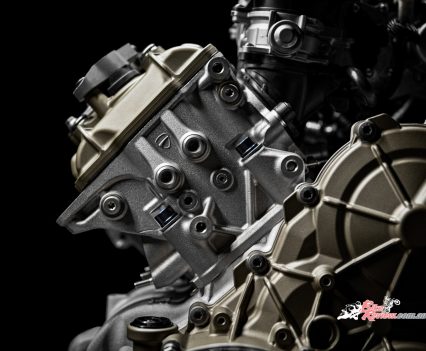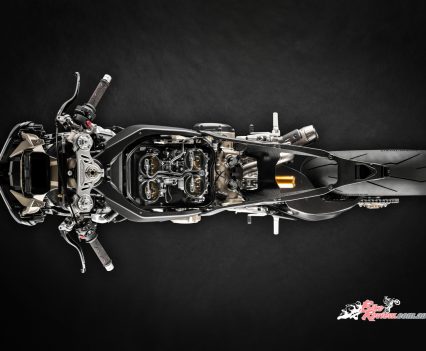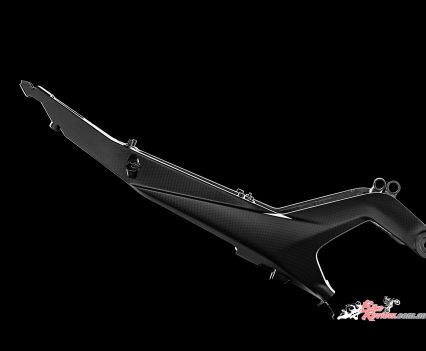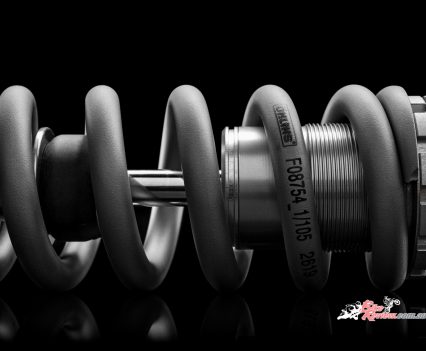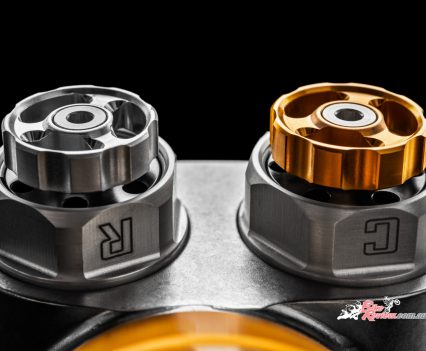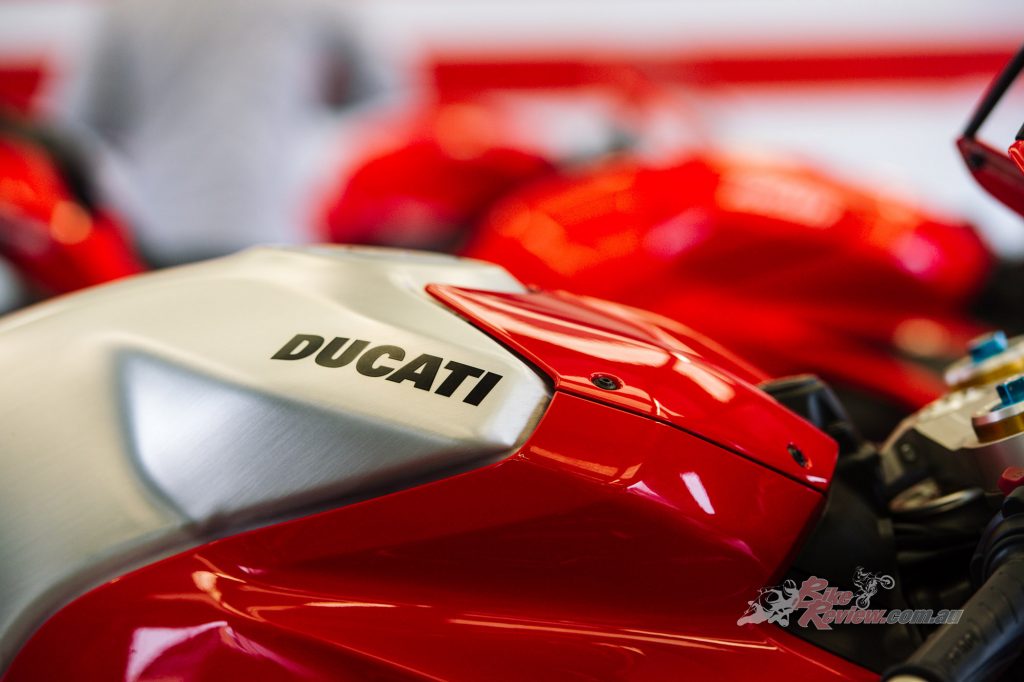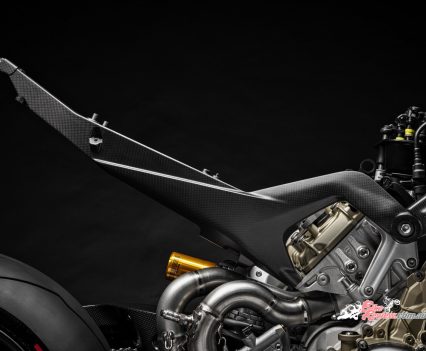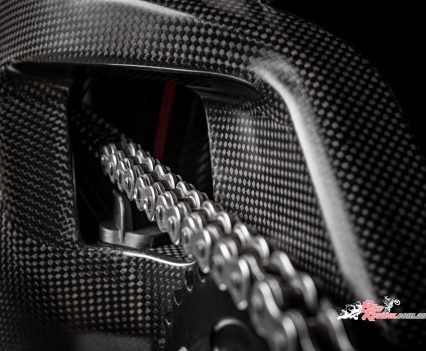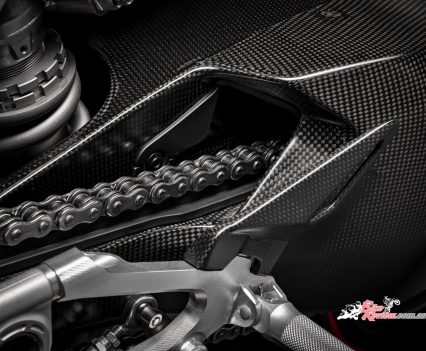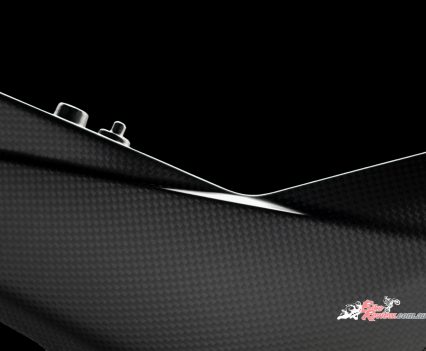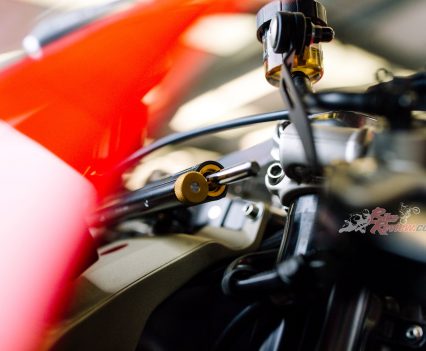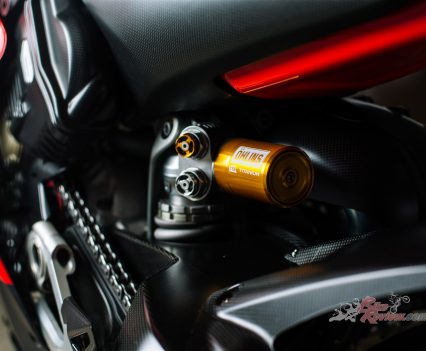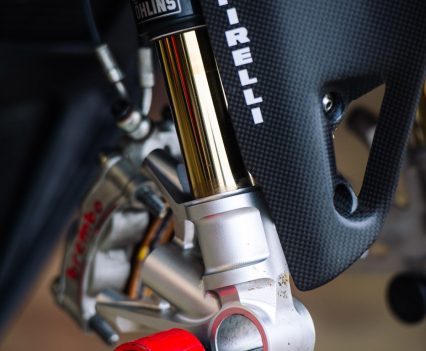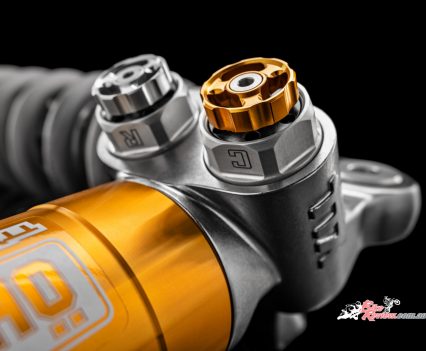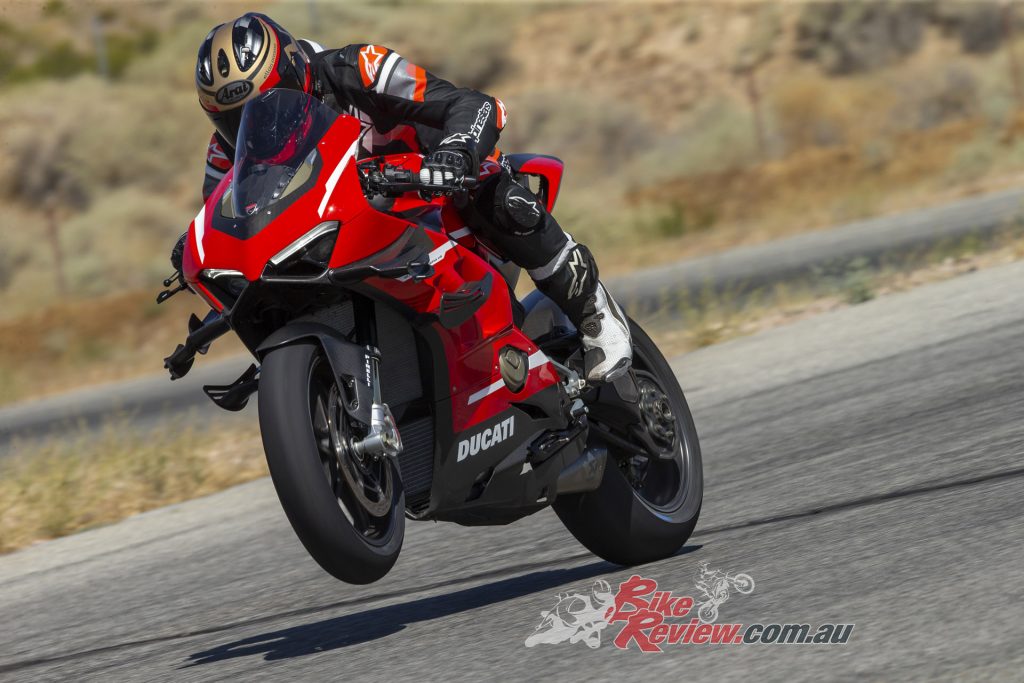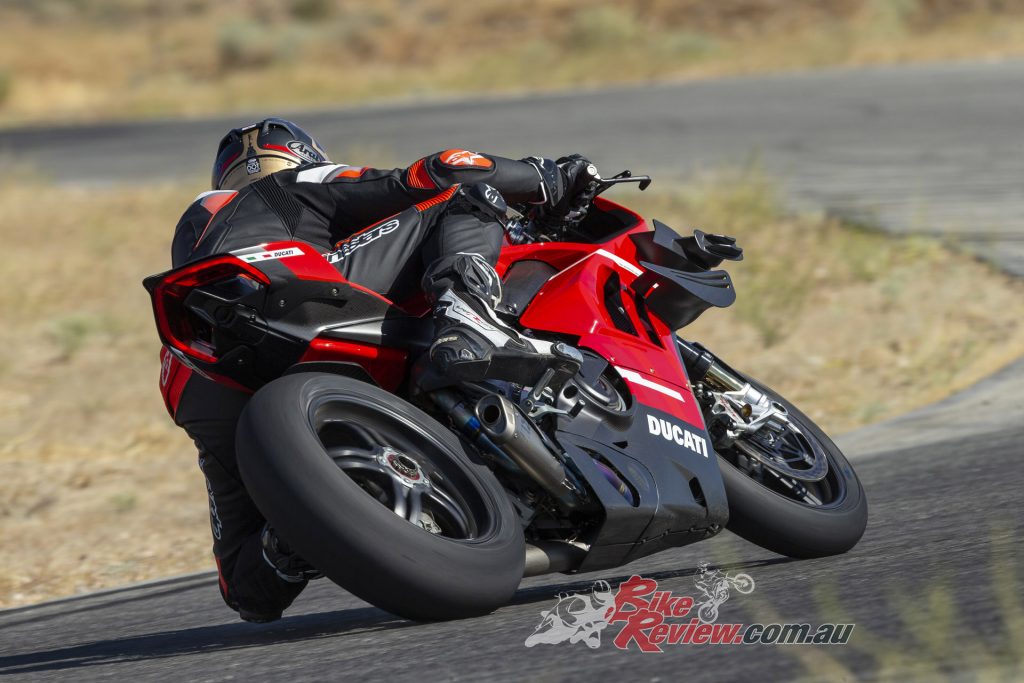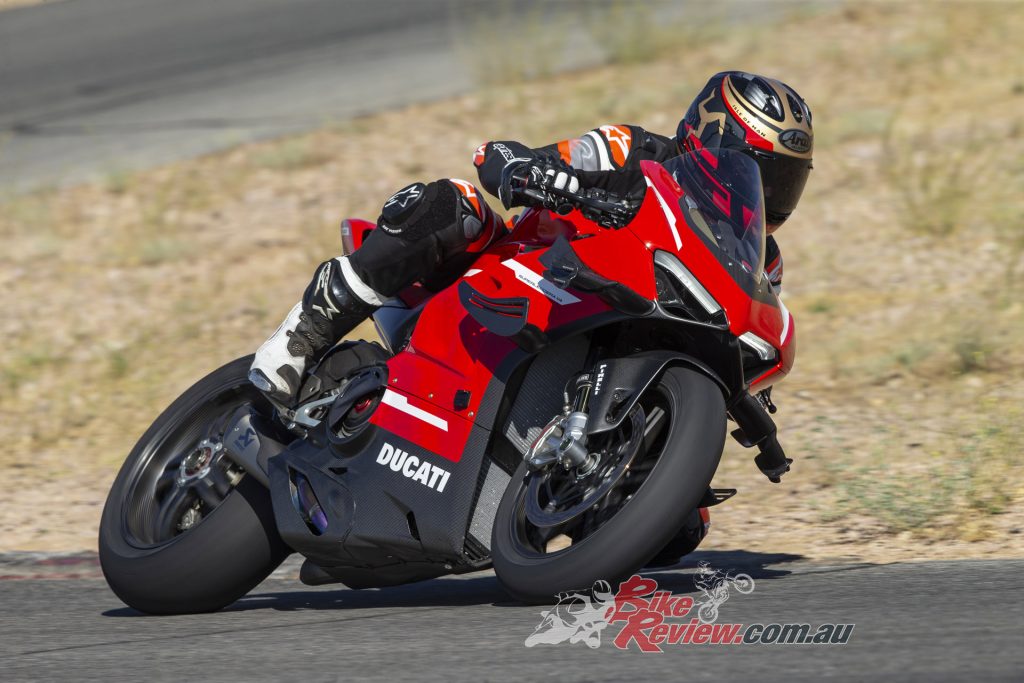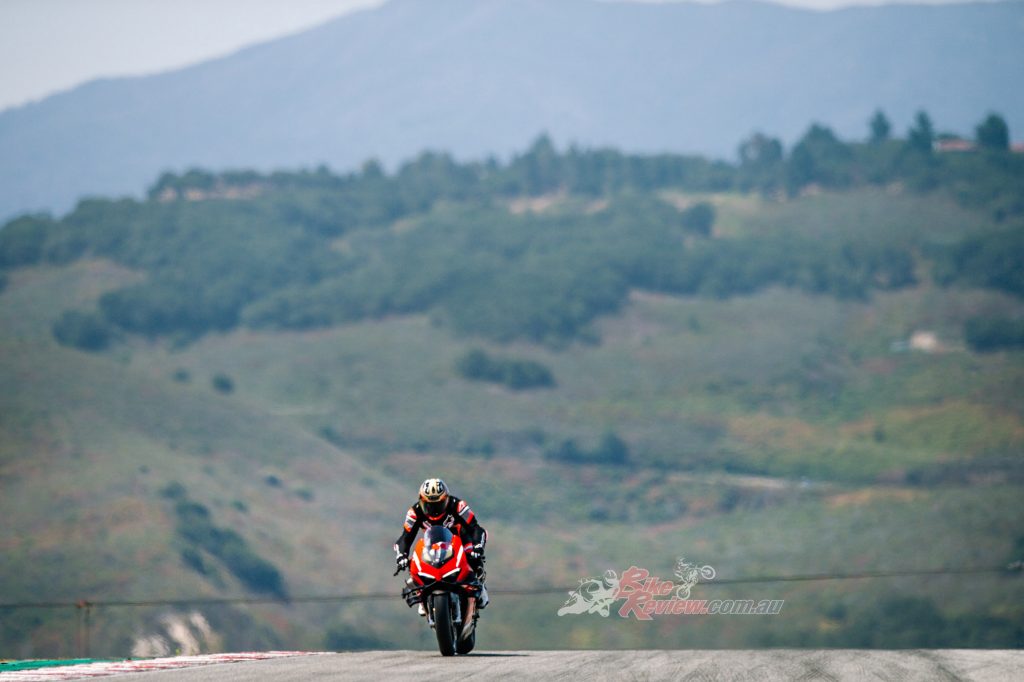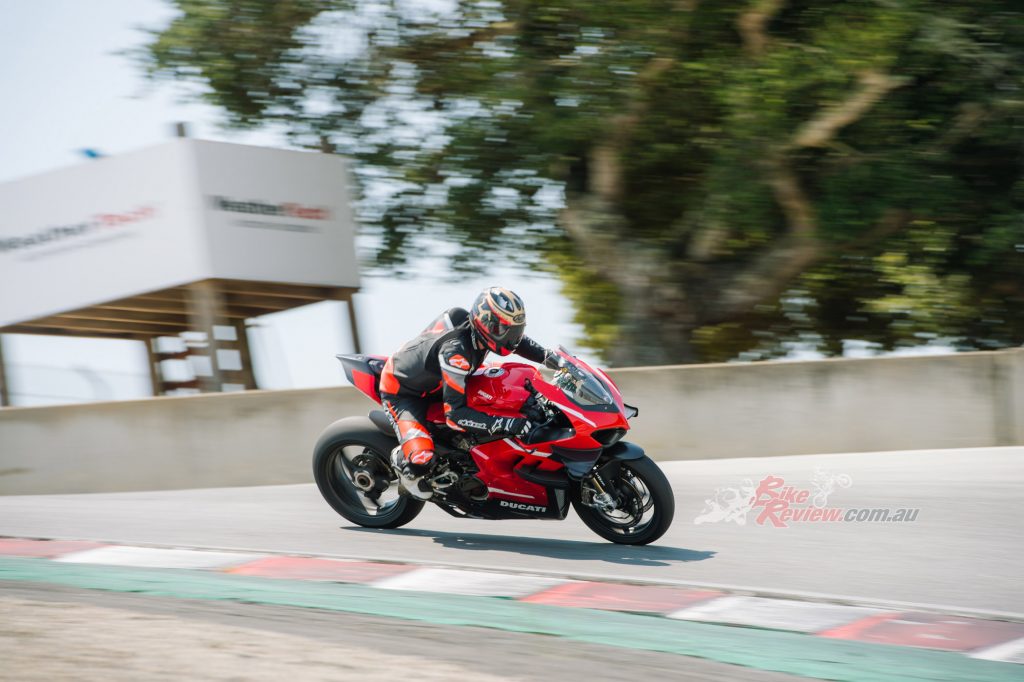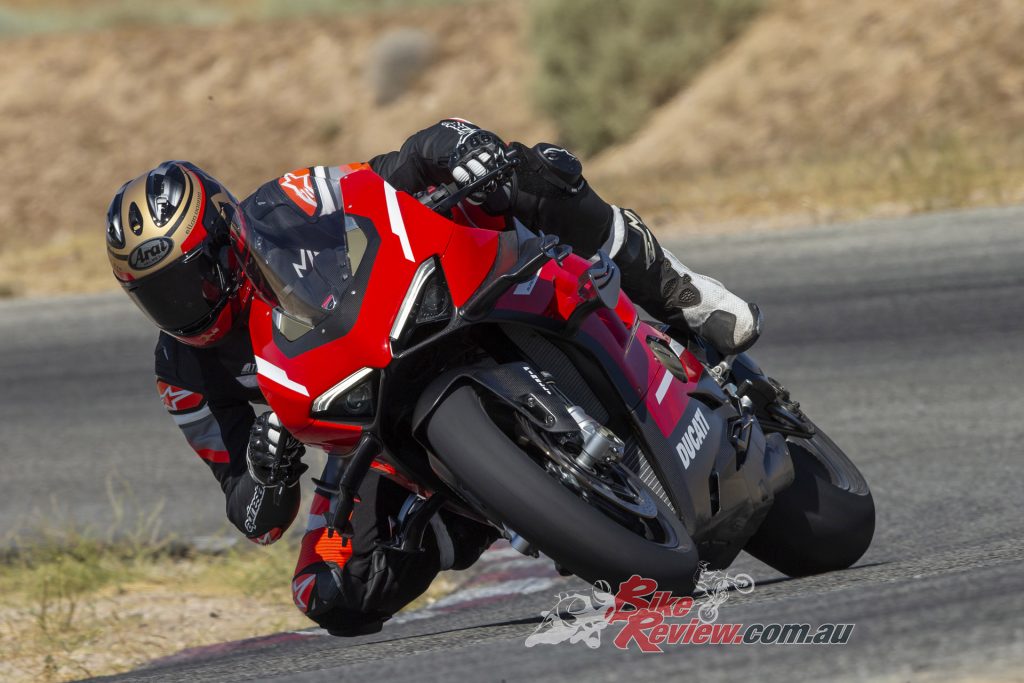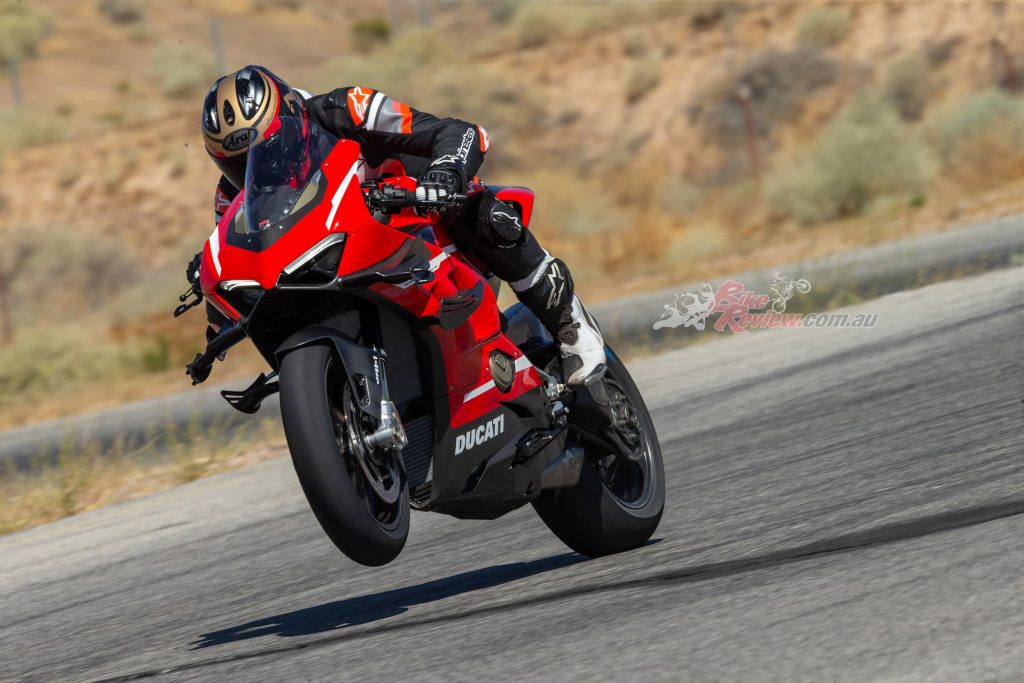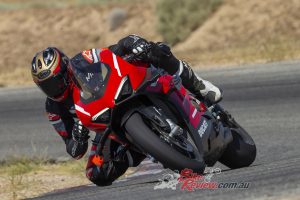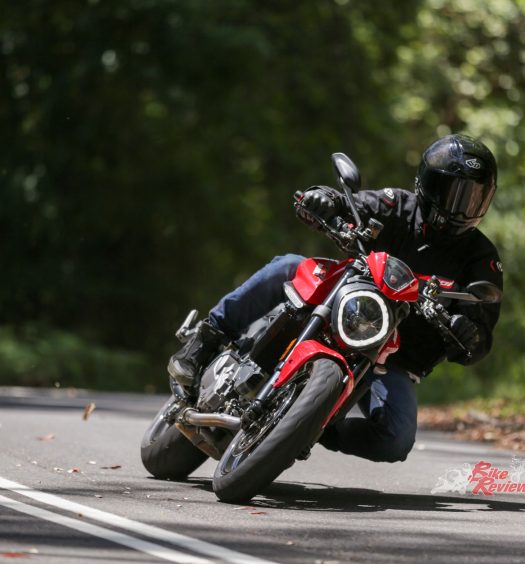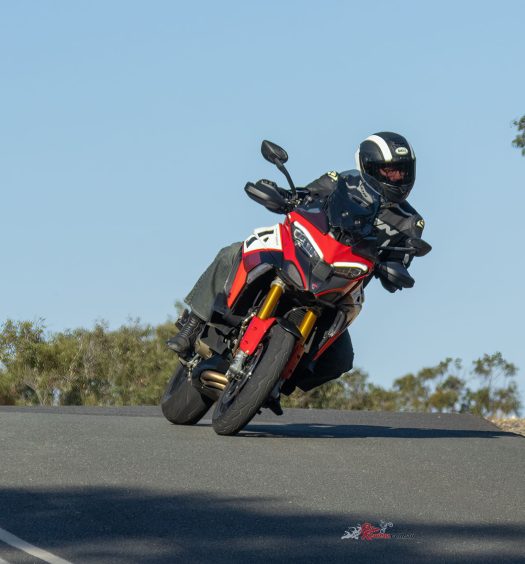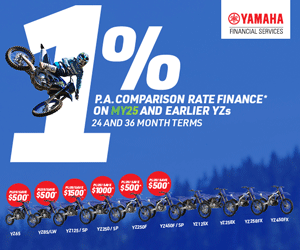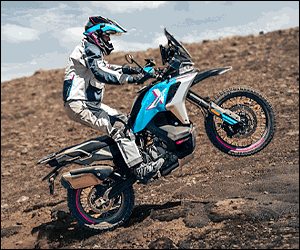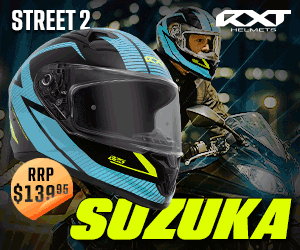With 224hp, a whopping 15,250rpm rev ceiling and carbon-fibre everywhere, the Superleggera V4 is the latest 'best ever' proddie superbike. We go Stateside for a ride... Photography: Kevin Wing/Ducati North America
To stand before a Ducati Superleggera V4 is to be in the presence of celebrity. A machine built to the nth degree of design, manufacturing, and sheer exhilaration standards, the Superleggera is the kind of bike you dream of riding as a kid…
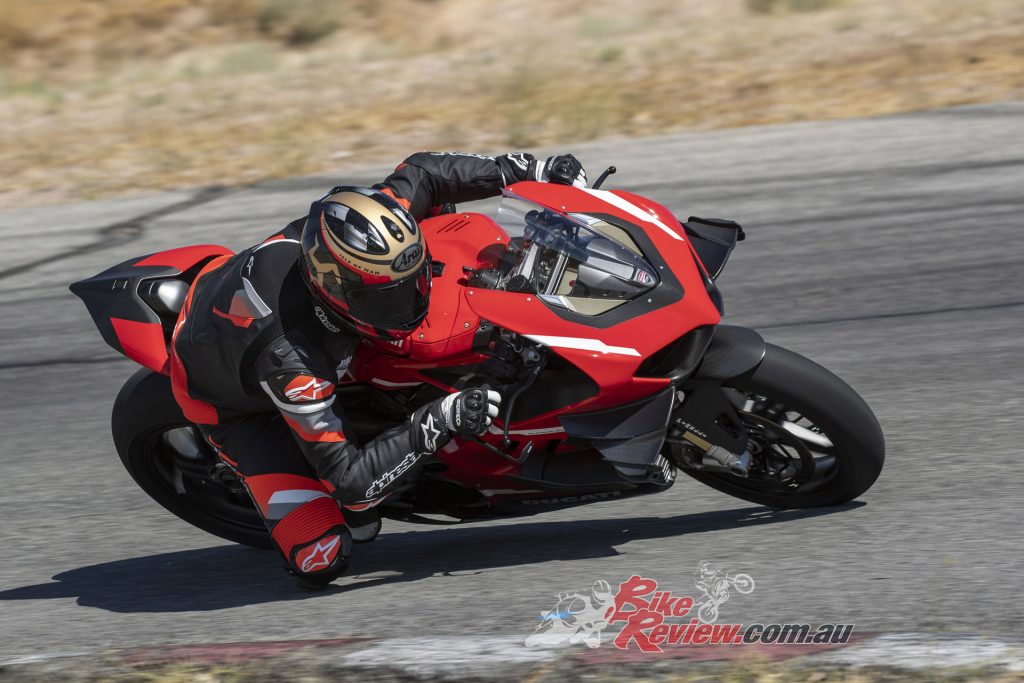
DJ Renski tested the Superleggera at Laguna Seca & Willow Springs and rates it as the best sportbike he has ridden.
And, if you’ve been smart enough throughout your life and kept a few coins in the bank, perhaps even owning. What makes the Superleggera special isn’t necessarily the 224 horsepower 998cc V4 that’s been swiped from the Panigale V4 R. Or the fact that said motor can be bumped up to a face-melting 234 horsepower once you fit the delectable Racing Kit Akrapovic titanium exhaust that comes with the bike at purchase. Or the fact it’s limited to just 500 units worldwide. It’s the liberal use of carbon-fibre in everything from the Front Frame, to the swingarm, wheels, bodywork, sub-frame, and, of course, the winglets. More on that in a tick.

2020 Ducati Super Legerra V4, you could probably build a similar spec Panigale for half the price but who cares?
Let’s start with the thing most recognisable to the public, that being the motor. Starting its life as the same hunk of metal currently powering Scott Redding to the lead of the WorldSBK Championship, the Panigale V4 R-sourced motor produces a claimed 224hp@15,250rpm, with torque specified at 115Nm@11,750rpm.
Just think about that for a second. This is a production motor capable of revving to over 15,000rpm, never mind the plus-230 horsepower figure. Time was not so long ago that 13,000rpm was almost the holy grail for superbike engineering, now Ducati has pushed the needle way past the 15K mark. Yamaha still hasn’t cracked 14,000rpm, with power on a YZF-R1M (depending on the dyno operator), lurking around 190-195hp at 13,500-13,750rpm.
And then, once the Titanium exhaust is fitted and the ECU flashed, you get 250rpm more and another 10hp, another two newton metres of torque, albeit at the same rpm.
Interestingly, Ducati hasn’t reinvented the wheel when it comes to the Superleggera version of the V4 R motor. The gains have been made in the name of lightness, rather than boring/stroking/shaving. Titanium bolts have been strategically used throughout the motor (not all bolts are Ti), there’s a new, lighter STM EVO-SBK eight-disc dry clutch, Titanium manifolds and an oil pump that works without a return stage from the cylinder-heads.
These factors alone have given the V4R-derived motor a 2.8kg weight saving over the 1103cc V4 that sits in the Panigale V4 S, which goes a way to showing where the performance gains have been made.
The motor is still the same basic V4 that sits in the V4 R. Still present is the counter-rotating crankshaft, which is a first for the Superbike category but not for production sportbikes (local rivals MV Agusta beat them to that claim on the F3 800).
The camshafts have been lightened, but still come with the same lift and duration for the 34mm Titanium intake valves and 27.5mm steel exhaust valves, and you still get the Twin Pulse firing order that was first developed for the Desmosedici GP3 that Loris Capirossi and our own Troy Bayliss raced with in 2003.
The Twin Pulse system fires at 0°, 90°, 290° and 380°—the two left cylinders fires together, followed by the right ones, making the Superleggera essentially a V-twin on ’roids (Ducati may be building V4 superbikes, but they’re still a V-twin company at heart).
Ducati purists will rejoice at the fact the Superleggera comes with a rattly dry clutch, which is commonplace on the company’s racebikes. Better feel under braking and through corners is the company reasoning for its fitment, but a little extra weight saved over a wet clutch is also a factor.
Getting the go to the ground is a Regina ORAW2 chain turning an Ergal crown, the same set-up used by Dovi in MotoGP. There’s another 1.4kg saving over the base Panigale here, and then we start looking at the chassis.
Put simply, the chassis is the single best Ducati can make for sale to the public. It’s a stunning study in woven black magic and a testament to how far the development and use of carbon-fibre has come.
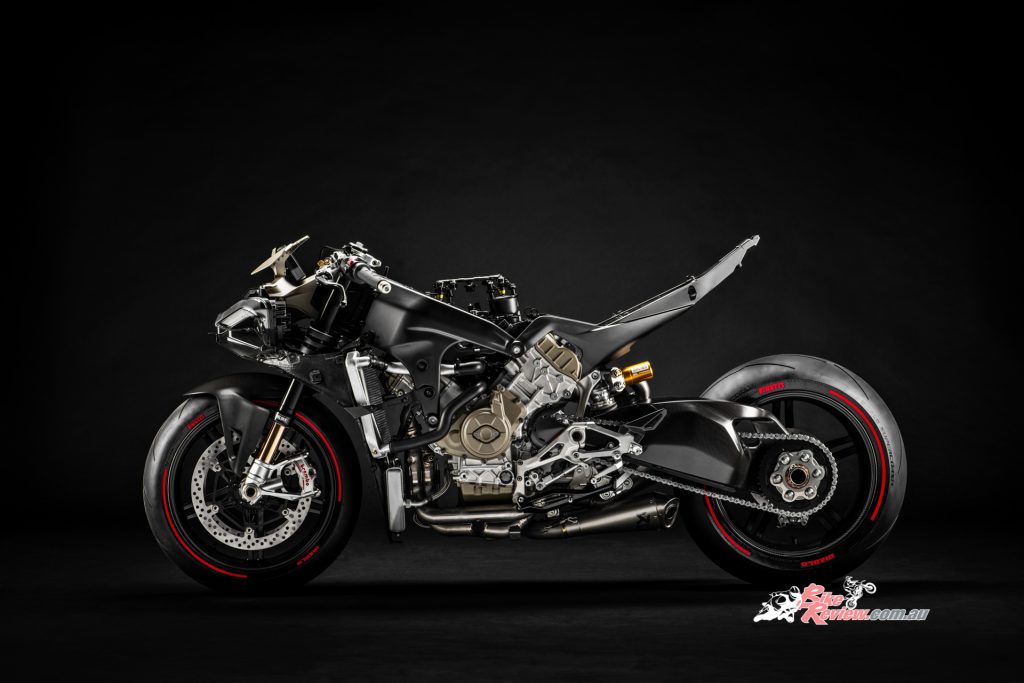
The Twin Pulse system fires at 0°, 90°, 290° and 380°—the two left cylinders fires together, followed by the right ones.
Carbon-fibre has come a long way since Cagiva put the first chassis made from the exotic material on a 500cc Grand Prix grid for the Czechoslovakian and Hungarian races in 1990 with Randy Mamola and Ron Haslam at the helm. Back then, the understanding of lateral and torsional stiffness was in its absolute infancy, and the Cagiva design—while beautiful—was a disaster. The chassis was so stiff it almost chattered the rider’s teeth out, and Cagiva quickly reverted to an aluminium chassis for 1991.
In 2008, Ducati bought carbon-fibre chassis technology back into MotoGP with Casey Stoner, who incidentally loved the carbon monocoque after a championship season on the steel trellis frame in 2007, although no one else did. When Valentino Rossi joined Ducati in 2011, he hated the carbon monocoque with such zeal that Ducati changed frames mid-season (multiple times) to various aluminium twin-spar versions to appease its Italian mega star.
Carbon-fibre monocoque/chassis may have been dead in the MotoGP water ever since (although carbon swingarms, bodywork and fork sliders are still very much in use), but that didn’t stop Ducati exploring the material for its high-end superbike range.
The Superleggera V4 is the third such superbike to come from Ducati using carbon-fibre as the main material for chassis. The first two Superleggera’s of 2014 and 2016 used carbon for the monocoque, and when the V4 platform with its Front Frame design emerged in 2018, it was inevitable we’d see a carbon-fibre Superleggera V4 hit dealer floors.
“The Front Frame has been created with the layout of the V4, which has been challenging for the design guys to create in carbon-fibre,” says Ducati Superbike Performance Development Manager, Carlo Ricci Maccarini. “But the target has been met because with this frame, we not only revealed the carbon frame with the same shape of a cast aluminium one, but we also had the chance to fine tune the stiffness.”
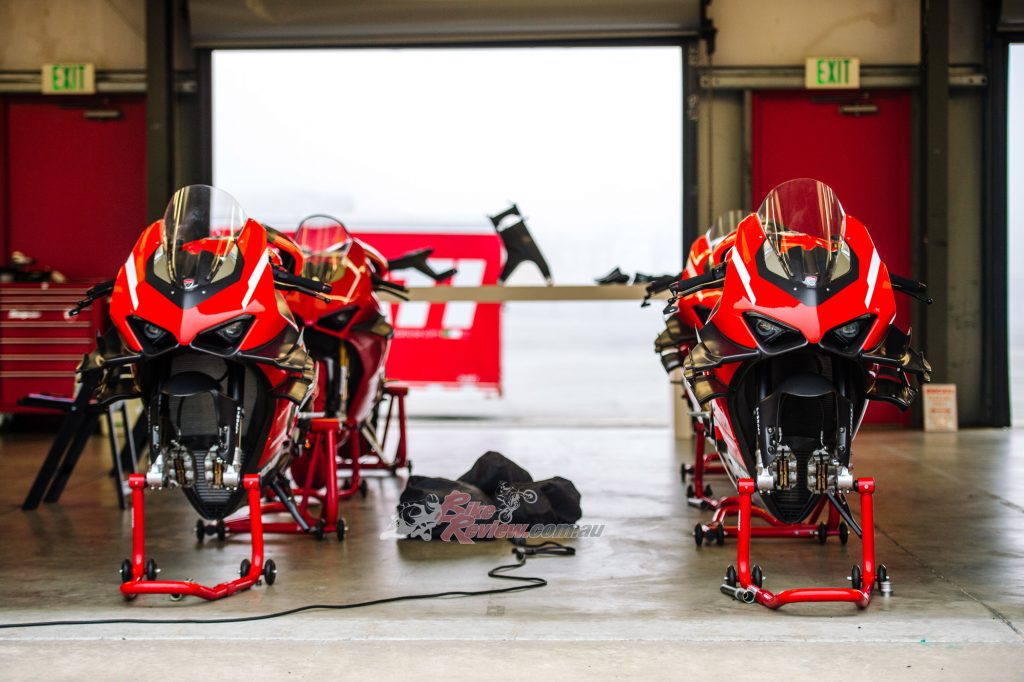
The Ducati engineers defined a play book for the new chassis that reduced the braking, torsional and lateral stiffness when compared to the V4 R.
Typical thinking would have the Superleggera’s carbon-fibre Front Frame as the stiffest of all three Panigale V4’s on sale, but you’d be wrong. It’s actually the reverse. The V4 R, which essentially exists as Ducati’s homologation machine to go WorldSBK racing, isn’t as stiff as the road-going V4 S (Check Out Our Review Here), and the Superleggera was therefore required by Ducati Corse to investigate a lower stiffness reference. The Ducati engineers defined a play book for the new chassis that reduced the braking, torsional and lateral stiffness when compared to the V4 R.
“On the V4 R, we made two openings on the side walls, and we also put reinforcement on the lower part to match the new set of stiffness numbers that Ducati asked of us,” says Maccarini. “On the carbon-fibre frame, we moved even lower with the numbers with a reduction of 27 per cent in braking stiffness, and 10 per cent in torsional stiffness when compared to the V4 R.
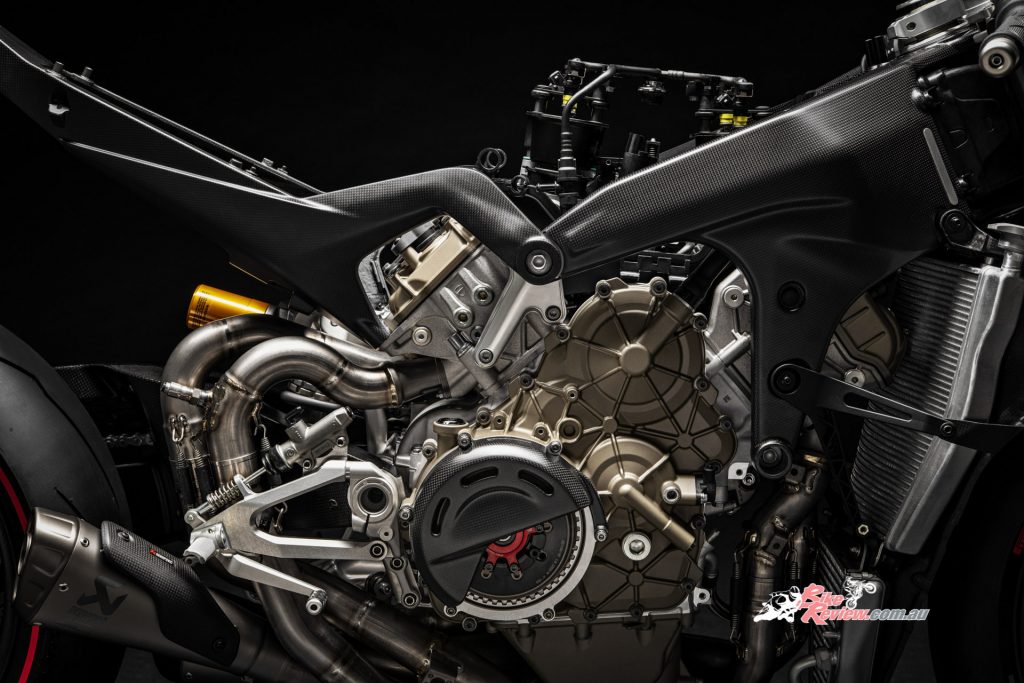
Typical thinking would have the Superleggera’s carbon-fibre Front Frame as the stiffest of all three Panigale V4’s on sale, but you’d be wrong. It’s actually the reverse.
“The combination of torsional and braking stiffness brought a reduction in lateral stiffness by six per cent. The less you can go with the stiffness number of the frame, without going over the problem of chattering, gives a better feeling to the rider, who will have more confidence over bumps, more tyre contact patch on the ground and a better feeling and grip at maximum lean. This is the idea we followed during the design and development of this bike”.
Less stiffness combined with the huge reduction in overall mass makes the Superleggera V4 a very special ride indeed. A quick glance through the list of the reductions makes for impressive reading. Compared to a standard Panigale V4, the carbon Front Frame is 1.1kg lighter; carbon swingarm is 0.9kg less, 1.1kg is gone from the carbon sub-frame, and 3.4kg has been taken off the wheels. Carbon-fibre components are everywhere, and that’s before you start looking at the bodywork.
“Similar consideration was also given to the wheels,” says Maccarini. “We already used these carbon wheels on the Superleggera of 2016. Consider that moving away 3.4kg from the two wheels, it makes a big difference in terms of lightness”.
The smattering of carbon-fibre structural components almost overshadows the behemoth that is the carbon bodywork. Modelled on the Desmosedici GP16 of Andrea Dovizioso and Andrea Iannone, when aerodynamic regulations were not as tight as they are now in MotoGP, the Superleggera uses a bi-plane design that forces 50kg on downforce onto that chassis at 270km/h. It’s like parking a fat Labrador on the front of your bike as you rip down the straight!
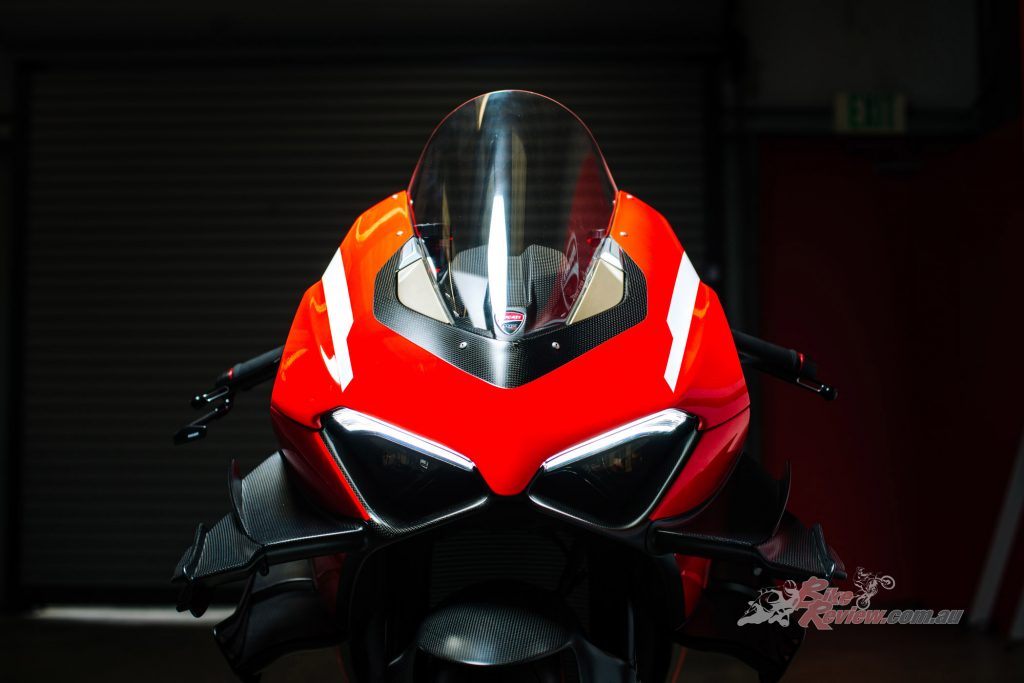
the Superleggera uses a bi-plane design that forces 50kg on downforce onto that chassis at 270km/h. It’s like parking a fat Labrador on the front of your bike as you rip down the straight!
Moving onto the suspension and brakes, the Superleggera V4 runs what can only be described as the ultimate in production Ohlins in the 43mm inverted NPX25/30 pressurised fork with machined-from-solid aluminium fork bottoms and a TTX36 shock running a lightweight titanium spring.
Brakes come in the form of the twin 330mm Brembo rotors and Brembo Stylema R four-piston radially-mounted calipers, which get fed their stopping power by a race-spec Brembo MCS 19.21 radial master-cylinder. The rear brake is a twin-piston Brembo caliper clamping on a single 245mm rotor. Like the suspension, the brakes are best you can get in a production system without delving into the race-only parts of the respective catalogues.
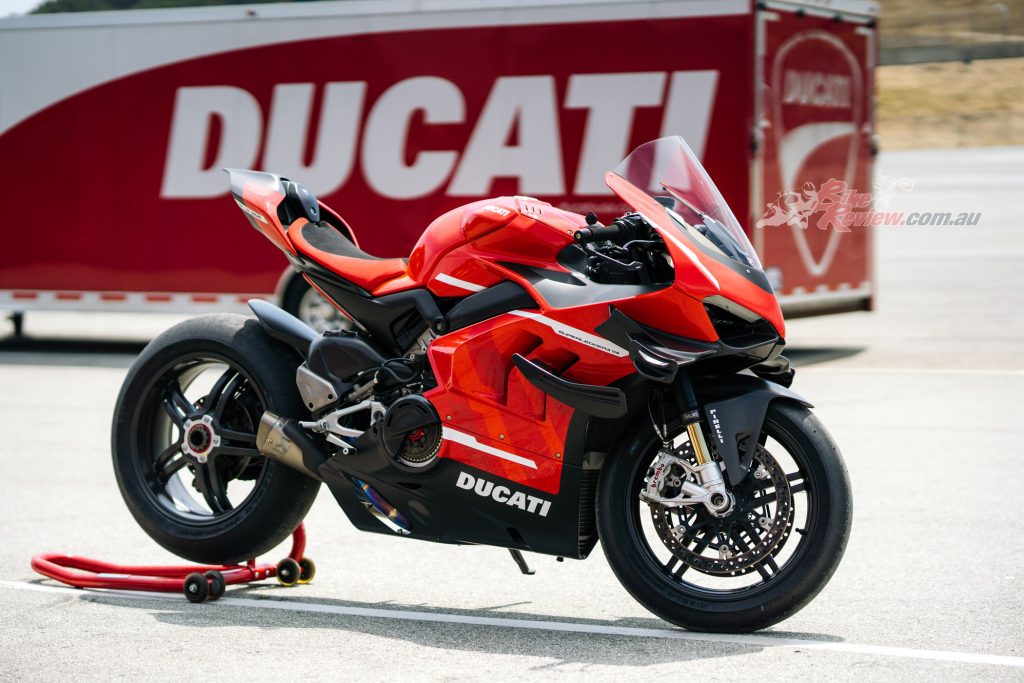
Brakes come in the form of the twin 330mm Brembo rotors and Brembo Stylema R four-piston radially-mounted calipers
The electronics are evolutionary updates of what you’ll find on the V4 R. Using the ubiquitous six-axis IMU, you’ll get the same Cornering ABS EVO algorithm, the same for the Ducati Slide Control, Ducati Power Launch, Engine Brake Control, and Wheelie Control.
The Ducati Traction Control system has been recalibrated for the increased horsepower and reduced weight of the Superleggera (Ducati claims it was taken from Dovi’s GP18), and the timing has been altered on the Ducati Quick Shift system to provide the fastest possible shifting time.
There’s three pre-set riding modes to choose from—Sport gets you full power but a softer throttle response with the highest level of ABS/rear wheel lift intervention; Race B gets you full power but reduced torque in the first three gears and Race A gives full power with about as close to a 1:1 throttle-rear wheel connection as you can get.
These modes also come with different levels of ABS intervention, plus the Slide By Brake function, which is supposed to let you back it into the corner like a pro (this, in our opinion, is better left to, you know, pros, unless you have a spare bike or two).
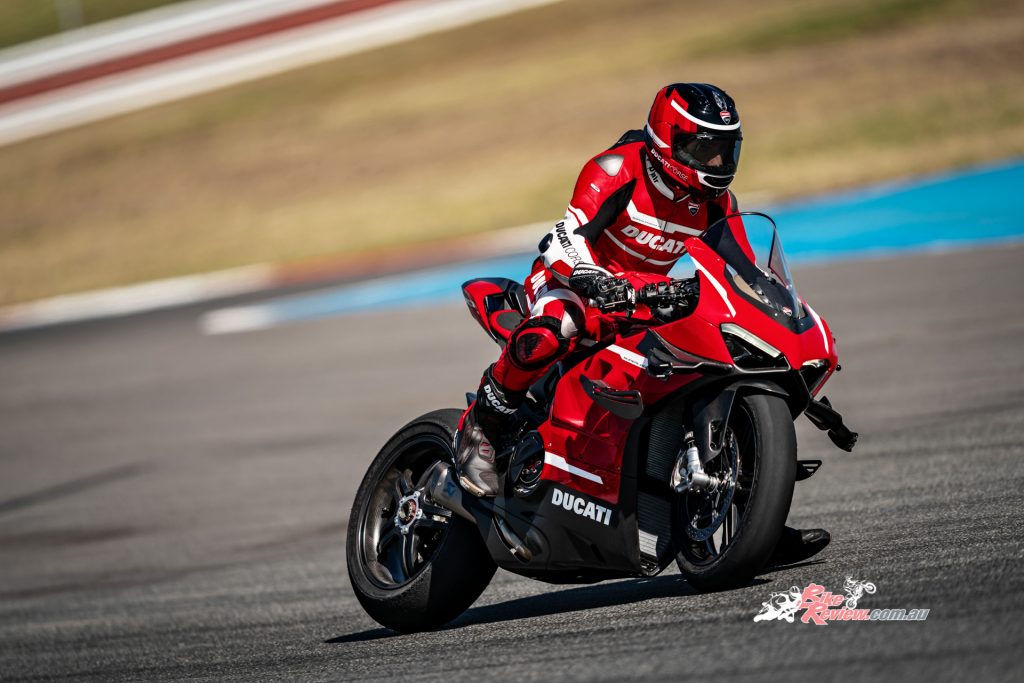
Don’t go throwing your 160k Duke down the road showing off in Slide By Brake Mode and backing it in!
There’s also the five additional maps you can save in the ECU that have your preferred settings for traction, wheelie, slide control, power levels, ABS, etc. You can easily dial in the ideal map for any riding situation, or get electronically lost trying to do so.
Speaking of electronics, the Superleggera also comes with the Ducati Data Analyser feature that data logs your progress over the course of your ride/lap, and you can change the five-inch dash to be the same as Dovi’s GP20 Ducati MotoGP bike where there’s no rev counter, a massive gear position indicator, lap timer and lap number, and display for traction control, wheelie control, slide control and engine braking control.
Right. Now all that’s out of the way, what’s it like to actually ride?
Ten laps is not a long time to test anything properly, but it’s more than you get in a WorldSBK test, for example. There you normally get four laps, at which point you learn pretty much bugger all about a bike except for “it’s really fast and steers heaps good”.
However, the fact that Ducati even offered us the chance to ride the Superleggera around Laguna Seca on California’s stunning central coast shows just how proud of their baby they really were. Manufacturers who build these bikes don’t normally hand them to greasy hand journo’s, so we’ll take it while we can. We rode the bike at Willow Springs as well.
Sitting atop the Superleggera, your peripherals are immediately filled with the black lines of carbon-fibre winglets protruding either side of the cockpit. By adding the wings you’re essentially making the bike one-third wider, and they make the bike look and feel massive. Our ride was cut into two five lap sessions—the first five had us in the Race B mode setting, with the main course Race A after lunch.
Firing that Akro up provides one of the most guttural, primal roars any motor inside any machine as ever created. Ever. It’s a deep, angry growl, a tiger compared to the pussycat of the Panigale V4 S.
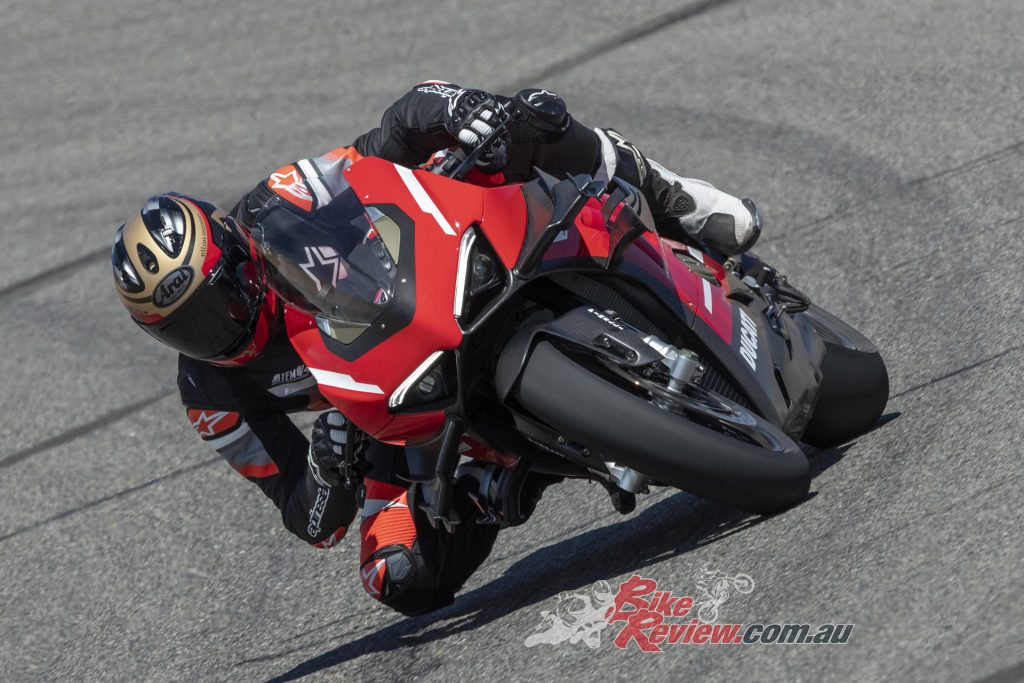
Firing that Akro up provides one of the most guttural, primal roars any motor inside any machine as ever created. Ever. It’s a deep, angry growl, a tiger compared to the pussycat of the Panigale V4 S.
Clicking first gear and rolling down the ultra-narrow pitlane, you immediately feel the weight difference between this and the Panigale V4 R that I’d done my installation laps on. Weaving side to side, you immediately notice the missing 22kg (claimed) as the Superleggera feels decidedly lighter while being wider in your vision. Strange.
But when you roll through the first few corners, you know you’re on something very, very special.
The lack of weight, combined with the enormous speed that the motor rips through the rev range, puts the Superleggera into its own realm. And when you combine the sheer velocity with the downforce of the winglets, all the tech Ducati throws at you suddenly becomes mechanically identifiable.
Ripping up the Rahal Straight (named after Indycar legend, Bobby Rahal) and towards the Corkscrew, the Superleggera stayed almost entirely planted. A steep incline with second, third, and fourth gears thrown at it, and barely any wheelie or for that matter, any intrusion from the wheelie control.
The wings were clearly doing their job, holding the front down under acceleration but conversely putting lots of force through the tire so when the anchors were squeezed, the tire was already in firm contact with the tarmac for loading. It’s nice when mechanical thinking trumps electronic intervention.
Through the Corkscrew, the second impressive trait of the Superleggera seeps through. The direction change happens at the speed at which the thought enters your head, and the feel on the side of the tyre is beautifully tangible, allowing you to know at any point what the back’s doing, and what the front’s doing. This is in no doubt thanks to the performance from the Ohlins NPX fork, which is hands-down the best production fork I’ve ever ridden. About 12 years ago, I rode Alex Debon’s factory RSW250 Aprilia, and I can only think of that bike when comparing the feel of the Superleggera (although Debon’s was much stiffer).
Scything down through the Rainey Curve and down towards the final left before the straight, another factor shines through, that of the brake set-up. Over the years I’ve become a real stickler for brakes and the Superleggera’s is by far the best I’ve used on a production machine that wasn’t race-prepped. What you ask for at the lever, you get. There’s no lag in the lever, not waiting for the power to come in, it’s absolutely spot on as I tip into the left hander, pick the chassis up, and unleash 234 horsepower down the straight.
Oh yeah, did I mention it’s got 234 horsepower? As amazing as that is, it’s not the star of the show. The power is demonic, but the chassis and braking package, when combined with the wings, is just so damn good you almost forget about the power underneath you.
When I go out for my second session, this time in Race A mode, the engine’s ferociousness comes to the fore a little more. With a more direct throttle response, the Superleggera is allowed to have its head more. The power hits harder, the visceral punch of the 998cc motor all the more real.
Laguna Seca being what it is, I barely hit middle revs in fifth gear on road gearing going into turn one. Seat of the pants is about 220km/h, maybe a bit more, but the Superleggera is well and truly capable of over 300km/h (I’m thinking Mike Jones, a nice run out of MG and an open Gardner Straight at Phillip Island will do the trick).
The revamped Ducati Quick Shift system works a treat, allowing for a more precise feeling, especially on downshifting. I’ve not really been a fan of the system on the V4 R and V4 S, but it’s very direct on the Superleggera. It fits perfectly with the bike, which is a precision instrument par excellence.
This is absolutely the best production superbike I’ve ever ridden. For the price, it better be. And the sad irony is for the price, many of the 500 thoroughbred superbikes will probably go in glass cases, living rooms, or personal museums, rather than get thrashed out on track. Oh well, I guess I can count myself lucky to have been one of the 12 journalists in the world to have ridden it, even if I’ll never afford it.
2020 Ducati Superleggera V4 Superbike Specifications
Price: $160,000 Estimated Price (AUD)
Claimed Power: 165kw[224hp]@15,250rpm
Claimed Torque: 116Nm[85.6lb-ft]@11,750rpm
Dry Weight: 159kg
Fuel Capacity: 16L
Engine: Desmosedici Stradale 90° V4, 81 x 48.4mm, 998cc, 14.0:1, 4-2-1-2 exhaust system w/ two catalytic converters and two lambda probes.
Gearbox: Six speed with quick-shift.
Clutch: Hydraulic slipper dry clutch.
Chassis: Carbon-fibre Front Frame, carbon-fibre single-sided swingarm
Rake: 24,5°
Trail: 100mm
Suspension: 43mm lightened fully adjustable Öhlins NPX25/30 pressurised fork, fully adjustable Öhlins TTX36 with GP valving and titanium spring.
Brakes: 2x330mm rotors (f), radially mounted Brembo Monobloc Stylema R 4-piston callipers, 245mm rotor (r), 2-piston calliper.
Wheels/Tyres: 5-split spoke carbon fibre, 3.50 x 17in (f) – 6 x 17in (r), Pirelli Diablo Supercorsa SP, 120/70 x 17in (f) – 200/60 x 17in (r)
Dimensions
Wheelbase: 1,480mm
Seat height: 835mm
Instruments: TFT 5in HD Colour Digital Instrumentation
The Verdict | Review: 2020 Ducati Superleggera V4, Launch Report


